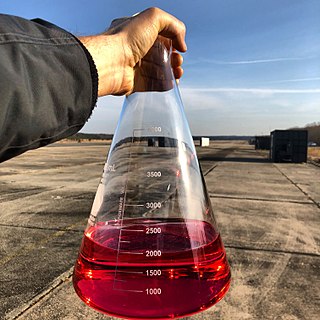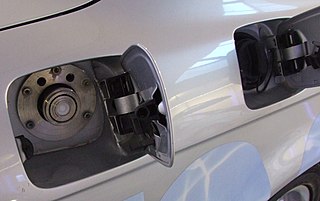Related Research Articles

In physics, cryogenics is the production and behaviour of materials at very low temperatures.

Liquid hydrogen (H2(l)) is the liquid state of the element hydrogen. Hydrogen is found naturally in the molecular H2 form.

Liquid nitrogen—LN2—is nitrogen in a liquid state at low temperature. Liquid nitrogen has a boiling point of about −195.8 °C (−320 °F; 77 K). It is produced industrially by fractional distillation of liquid air. It is a colorless, low viscosity liquid that is widely used as a coolant.

Liquid oxygen—abbreviated LOx, LOX, LOXygen or Lox in the aerospace, submarine and gas industries—is the liquid form of molecular oxygen. It was used as the oxidizer in the first liquid-fueled rocket invented in 1926 by Robert H. Goddard, an application which has continued to the present.

RP-1 (alternatively, Rocket Propellant-1 or Refined Petroleum-1) is a highly refined form of kerosene outwardly similar to jet fuel, used as rocket fuel. RP-1 provides a lower specific impulse than liquid hydrogen (LH2), but is cheaper, is stable at room temperature, and presents a lower explosion hazard. RP-1 is far denser than LH2, giving it a higher energy density (though its specific energy is lower). RP-1 also has a fraction of the toxicity and carcinogenic hazards of hydrazine, another room-temperature liquid fuel.

The Brayton cycle is a thermodynamic cycle that describes the operation of certain heat engines that have air or some other gas as their working fluid. The original Brayton engines used a piston compressor and piston expander, but modern gas turbine engines and airbreathing jet engines also follow the Brayton cycle. Although the cycle is usually run as an open system, it is conventionally assumed for the purposes of thermodynamic analysis that the exhaust gases are reused in the intake, enabling analysis as a closed system.

A liquid-propellant rocket or liquid rocket utilizes a rocket engine that uses liquid propellants. Gaseous propellants may also be used but are not common because of their low density and difficulty with common pumping methods. Liquids are desirable because they have a reasonably high density and high specific impulse (Isp). This allows the volume of the propellant tanks to be relatively low. The rocket propellants are usually pumped into the combustion chamber with a lightweight centrifugal turbopump, although some aerospace companies have found ways to use electric pumps with batteries, allowing the propellants to be kept under low pressure. This permits the use of low-mass propellant tanks that do not need to resist the high pressures needed to store significant amounts of gasses, resulting in a low mass ratio for the rocket.

Liquefied natural gas (LNG) is natural gas (predominantly methane, CH4, with some mixture of ethane, C2H6) that has been cooled down to liquid form for ease and safety of non-pressurized storage or transport. It takes up about 1/600th the volume of natural gas in the gaseous state (at standard conditions for temperature and pressure).
Liquid air is air that has been cooled to very low temperatures, so that it has condensed into a pale blue mobile liquid. To thermally insulate it from room temperature, it is stored in specialized containers. Liquid air can absorb heat rapidly and revert to its gaseous state. It is often used for condensing other substances into liquid and/or solidifying them, and as an industrial source of nitrogen, oxygen, argon, and other inert gases through a process called air separation.
The highest specific impulse chemical rockets use liquid propellants. They can consist of a single chemical or a mix of two chemicals, called bipropellants. Bipropellants can further be divided into two categories; hypergolic propellants, which ignite when the fuel and oxidizer make contact, and non-hypergolic propellants which require an ignition source.
A coolant is a substance, typically liquid, that is used to reduce or regulate the temperature of a system. An ideal coolant has high thermal capacity, low viscosity, is low-cost, non-toxic, chemically inert and neither causes nor promotes corrosion of the cooling system. Some applications also require the coolant to be an electrical insulator.

Industrial gases are the gaseous materials that are manufactured for use in industry. The principal gases provided are nitrogen, oxygen, carbon dioxide, argon, hydrogen, helium and acetylene, although many other gases and mixtures are also available in gas cylinders. The industry producing these gases is also known as industrial gas, which is seen as also encompassing the supply of equipment and technology to produce and use the gases. Their production is a part of the wider chemical Industry.
Mixtures of dispersed combustible materials and oxygen in the air will burn only if the fuel concentration lies within well-defined lower and upper bounds determined experimentally, referred to as flammability limits or explosive limits. Combustion can range in violence from deflagration through detonation.

A bivalent engine is an engine that can use two different types of fuel. Examples are petroleum/CNG and petroleum/LPG engines, which are widely available in the European passenger vehicle aftermarket.

A turboexpander, also referred to as a turbo-expander or an expansion turbine, is a centrifugal or axial-flow turbine, through which a high-pressure gas is expanded to produce work that is often used to drive a compressor or generator.

An LNG carrier is a tank ship designed for transporting liquefied natural gas (LNG).
A liquid nitrogen vehicle is powered by liquid nitrogen, which is stored in a tank. Traditional nitrogen engine designs work by heating the liquid nitrogen in a heat exchanger, extracting heat from the ambient air and using the resulting pressurized gas to operate a piston or rotary motor. Vehicles propelled by liquid nitrogen have been demonstrated, but are not used commercially. One such vehicle, Liquid Air, was demonstrated in 1902.

A cryogenic rocket engine is a rocket engine that uses a cryogenic fuel and oxidizer; that is, both its fuel and oxidizer are gases which have been liquefied and are stored at very low temperatures. These highly efficient engines were first flown on the US Atlas-Centaur and were one of the main factors of NASA's success in reaching the Moon by the Saturn V rocket.
An air separation plant separates atmospheric air into its primary components, typically nitrogen and oxygen, and sometimes also argon and other rare inert gases.

A liquefied natural gas terminal is a facility for managing the import and/or export of liquefied natural gas (LNG). It comprises equipment for loading and unloading of LNG cargo to/from ocean-going tankers, for transfer across the site, liquefaction, re-gasification, processing, storage, pumping, compression, and metering of LNG. LNG as a liquid is the most efficient way to transport natural gas over long distances, usually by sea.
References
- ↑ Biblarz, Oscar; Sutton, George H. (2009). Rocket Propulsion Elements. New York: Wiley. p. 597. ISBN 978-0-470-08024-5.
- 1 2 Øyvind Buhaug (2011-09-21). "Combustion characteristics of LNG" (PDF). LNG Fuel Forum. Archived (PDF) from the original on 2012-12-22. Retrieved 2015-12-09.
- ↑ Oil and Gas Journal (2002-08-09). "LNG liquefaction technologies move toward greater efficiencies, lower emissions". Archived from the original on 2016-06-30. Retrieved 2015-12-09.
- ↑ Bill White (2012-10-02). "All you need to know about LNG". THe Oil Drum. Archived from the original on 2019-08-29. Retrieved 2015-12-09.
- ↑ Weldon Ransbarger (2007). "A Fresh look at LNG Process Efficiency" (PDF). LNG Industry. Archived from the original (PDF) on 2016-06-24. Retrieved 2015-12-09.
- 1 2 "What are the Benefits of LNG". 2015. Archived from the original on 2017-12-04. Retrieved 2015-12-02.
- ↑ Ramachandran, R. (2014-02-07). "Cryogenic advantage". Frontline. Archived from the original on 2014-03-29. Retrieved 2015-12-02.
- 1 2 Cryogenic Fuels, Inc. (1991-12-16). "Liquid Methane Fuel Characterization and Safety Assessment Report" (PDF). Metropolitan Transit Authority. Archived from the original (PDF) on 2018-10-09. Retrieved 2015-12-02.
- ↑ Asogekar, Nikhil. (2015-12-02). "Cryogenic Liquids-Hazards". CCOHS. Archived from the original on 2019-09-25. Retrieved 2015-12-02.